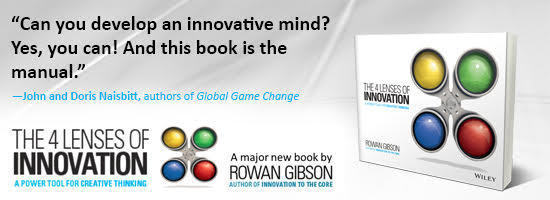Halloween Innovation

On this night of the annual tradition of All Hallow’s Eve, or Halloween, I was thinking about a shared experience that many of us likely remember from our youth – the house that no one wants to approach while trick or treating.
It seems that in many neighborhoods there is at least one house with few lights on a long, dark driveway, which appears uninviting to the local children who are festooned in their costumes and enjoying the right of ringing doorbells and shouting “trick or treat†to their neighbors. The younger the trick or treat participant, the more ominous even the shortest walk from the street to a darkened house can seem.
The experience of walking up to a particular house, ringing the doorbell with trepidation, and experiencing the scary moment when the owner opens the door and attempts to frighten the children contrasts sharply with the immense satisfaction a child feels when the scary moment has passed and he or she is rewarded with candy or other goodies from that previously daunting house.
In fact, subsequent scary houses seem less and less frightful as the night wears on and the process repeats itself throughout the neighborhood. This experience can prove informative to the modern practitioner of innovation, as the same process that we went through as children can sometimes re-appear as we are trying to drive innovation in a static environment.
The key innovation-related experiences from Halloween to consider are: paying attention to things one might not normally observe, embracing the haunted, and being bold by ringing the doorbell without fear.
The first admonition on Halloween is to be aware of one’s surroundings to an extent that is significantly greater than how one would behave on a normal day. While walking up to a house, one should be watchful and keep in mind that the homeowner might have hidden a noisemaker in a bush or have motion-sensing light switch that is intended to turn on suddenly to frighten visitors.
The trick or treater approaching a house should be on guard to notice things that one does not normally notice. This mindset is useful for the innovation practitioner as well…
…to the extent that finding innovation may require looking around us at our mundane, everyday surroundings to spot something that was always there before that that has implications that we might have previously missed.
A good example of this is the Waffle House indicator used in disaster management. W. Craig Fugate, formerly the Emergency Management Chief for the state of Florida and now the Administrator of the Federal Emergency Management Agency (FEMA), developed an innovative mechanism for determining the extent of damage from a natural disaster using the status of the ubiquitous Waffle House restaurants, which are open 24 hours a day and thus good sources of data on the availability of electricity, passable roads, and gas in an area.
Fugate’s measurements rated Waffle Houses as either green (open and serving customers), yellow (open but with a limited menu), or red (closed and inoperable). Rather than creating a complex mechanism for tracking the damage from a natural disaster using data from hundreds of sources with elaborate interfaces and algorithms, Fugate took an unconventional look at conventional information and derived innovative and useful insights for disaster management. Fugate looked at the obvious elements of his surroundings in a new way and demonstrated powerful innovation.
A second instructive element of Halloween for the innovator is the importance of embracing the ‘haunted’.
Most of the time we follow our natural instincts to avoid those locations where we sense danger. On Halloween, however, we walk straight into darkened rooms and move towards strange noises or sights rather than turning the other way and running. For the innovator, a comparable situation is the haunted failed project from the past that doubters will bring up anytime someone presents a new idea about solving an old problem.
For instance, a failed Enterprise Resource Planning (ERP) project from years ago will rear its ugly head anytime an innovator talks about transforming business processes using application-driven innovation. That entire area of discussion at a corporation can be viewed as “haunted†to the extent that people turn and flee from endeavors launched back into those areas. The innovator, on the other hand, is taught to embrace failure and not to shy away from those areas but, rather, to learn from them.
There are hundreds of articles in the innovation literature on the importance of failure, and one of my previous articles, Midden Innovation, addresses this concept by noting the value of shelfware as a history of past transformation projects, some of which could be viewed as “haunted†if they were not successful. In that shelfware, an innovator could find new ideas based on the present situation at a company and could use those failed ideas to develop new successes. Embracing the haunted could be a pathway to new thinking, especially if by averting their attention from a topic for many years, colleagues may have missed out on the opportunity to identify obvious insights.
A final aspect of Halloween for the innovator to consider is the need, in some situations, to simply walk up the steps and ring the doorbell as a bold action, even though other indicators suggest that the person should turn and go the other way. Boldness, in other words, has its time and place and can lead to rewards (treats) for the Halloween participant.
As innovators we should be bold and channel the mindset of a child who does not hesitate to knock on a scary door on Halloween.
In innovation, there is often no substitute for bold action. A great example of this comes from the British inventor Charles Parsons, inventor of the steam turbine in 1884. In the early 20th century, large ships used reciprocating steam engines to push pistons to turn their propeller shafts but had reached a brick wall in terms of the horsepower that could be generated by these engines.
In addition to requiring large amounts of space and weighing many tons, reciprocating engines vibrated incessantly and could be felt all over a large ship, which was a particularly bad attribute for a luxury cruise ship. Parsons designed a new engine that leveraged concepts from windmills in using pressure steam from boilers to blast a rotor with thousands of small blades. The rotor would turn a propeller shaft and could fit in a smaller space and yield significantly more power than the older designs.
The challenge for Parsons was to figure out how to get the conservative Royal Navy to pay attention to his new design, so he decided to “knock on the door†of the 1897 Naval Review at Spithead by launching his craft and darting in between the lumbering battleships and cruisers at a speed of 34 knots, successfully eluding the naval pilot boat that tried to corral him. Since the Naval Review was part of the Diamond Jubilee celebration for Queen Victoria, even the Queen herself had the chance to witness Parsons’ exploits and although he triggered outrage on the part of many in the Admiralty, other observers saw the innovation in Parsons’ engine and the power plant eventually found its way into the Royal Navy.
Parsons was bold in “knocking on the door” of this event, and where reasoned thought and analysis of his engine may have fallen short, his aggressive action of introducing his innovation to a broader audience cemented his successful development of what many consider to be one of the greatest breakthroughs in nautical engineering history.
Sources: Clay Dillow, “Comfort Food: How Waffle House became a disaster indicator for FEMA,†Popular Science (November 2013).
Steven Ujifusa, A Man and His Ship: America’s Greatest Naval Architect and His Quest to Build the S.S. United States (New York: Simon & Schuster, 2013).
image credit: history.com
Wait! Before you go…
Choose how you want the latest innovation content delivered to you:
- Daily — RSS Feed — Email — Twitter — Facebook — Linkedin Today
- Weekly — Email Newsletter — Free Magazine — Linkedin Group
 Scott Bowden is an independent innovation analyst. Scott previously worked for IBM Global Services and Independent Research and Information Services Corporation. Scott has Ph.D. in Government/International Relations from Georgetown University. Follow him on Twitter @sgbowden
Scott Bowden is an independent innovation analyst. Scott previously worked for IBM Global Services and Independent Research and Information Services Corporation. Scott has Ph.D. in Government/International Relations from Georgetown University. Follow him on Twitter @sgbowden
NEVER MISS ANOTHER NEWSLETTER!
LATEST BLOGS
Learning Innovations from Microsoft
Want to read up on the latest technologies or innovative business thinking? If you’re committed to continuous learning to maintain…
Read MorePossible Strategic Innovation in Tobacco?
Do you truly know how your customers want to consume your product? Cigarettes are of course typically sold by the…
Read More



